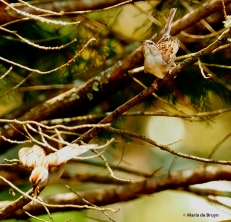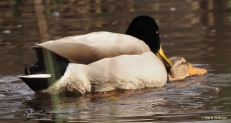As mentioned in a previous blog, when young birds are ready to leave the nest, they don’t necessarily look like their parents. Many of the altricial birds (ready to move about and forage on their own) may resemble fluffy versions of the adults, as is the case with these hooded merganser ducklings (Lophodytes cucullatus) following their mother.
The brown-headed nuthatch babies (Sitta pusilla) look very much like their parents. Sharp-eyed observers might notice that the tops of their heads are not as brown as those of their parents.
The Eastern meadowlark juveniles (Sturnella magna) resemble their parents but lack the bright yellow and black coloring on the throat and breast.
The difference between adult and juvenile downy woodpeckers (Picoides pubescens) is subtle. The female woodpecker has no coloring on the top of her head, which is simply bedecked with the white and black feathers that cover the rest of her body.
The male woodpecker has a red patch on the back of his head.
The immature woodpecker has a red patch on top if the head and this is lost as the bird reaches adulthood.
The Northern mockingbird youngling (Mimus polyglottos) resembles mom and dad quite a bit except for some spotty streaking on the chest.
In other species, the babies start out looking quite different from their parents. Spots characterize many members of the thrush family, with birds like wood thrushes (Hylocichla mustelina) and hermit thrushes (Catharus guttatus) retaining the spots in adulthood.
The Eastern bluebirds (Sialia sialis) and American robins (Turdus migratorius), on the other hand, are only strongly speckled as immature birds, losing their spots as they mature.
 In some cases, the birds undergo color changes. Male summer tanagers (Piranga rubra) start out yellow-orange with their reddish coloring appearing in patches until they finally achieve their very bright adult red hue. Some of the immature birds are really quite beautiful with their mottled colors.
In some cases, the birds undergo color changes. Male summer tanagers (Piranga rubra) start out yellow-orange with their reddish coloring appearing in patches until they finally achieve their very bright adult red hue. Some of the immature birds are really quite beautiful with their mottled colors.
The male blue grosbeaks (Passerina caerulea) start out brown and gradually achieve their dark blue feathers with some reddish/brown wing accents.
Among the birds that undergo a major change are the European starlings (Sturnis vulgaris). The young birds start out with dullish brown or gray hues with some streaking. Eventually, they begin to develop some spotting and then ultimately achieve the beautiful adult summer glossy feathering with green and purple hues mixed in.
The females of the Eastern towhee species (Pipilo erythrophthalmus) have a brown back above a white breast with reddish sides, while the males have black backs.
The young developing towhees keep you guessing as to their sex since they undergo quite a lot of color changes as they develop. They do have the white in their tails, which helps you identify them as to species.



 And then we come to the hawks and owls. It is not unusual for the young raptors to look nothing at all like their parents. The red-shouldered hawks (Buteo lineatus) start out looking like fluffy and then becoming gradually kind of scruffy looking.
And then we come to the hawks and owls. It is not unusual for the young raptors to look nothing at all like their parents. The red-shouldered hawks (Buteo lineatus) start out looking like fluffy and then becoming gradually kind of scruffy looking.
As they get a little older and leave the nest, they start to resemble their parents more but have more streaking on the breast. As they near adulthood, they look much more like mom and dad.
And we end with an example of another raptor. There is a real difference between the baby great horned owl (Bubo virginianus) and its parent as you can see. Many birds are impressed by the adults but ooh and aah over the nestlings. It must be the combination of those big eyes and fluffy feathers that take away attention from the already formidable claws!
Next up – a foray into the world of amphibians and reptiles!












































































































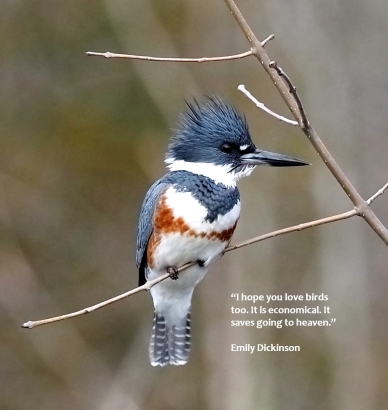









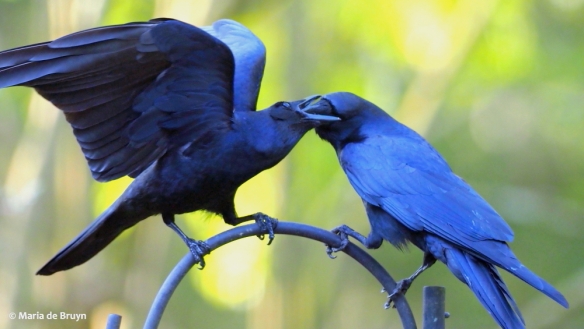







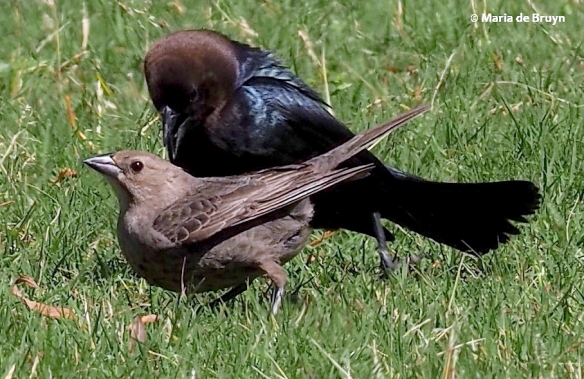
 The quickest mating scenario I’ve witnessed came from a pair of sweet little chipping sparrows (Spizella passerina). I’d seen the two fluttering together at the feeders and had noted one sparrow chasing another away – which I now think was the victorious suitor driving away a rival. Then one July afternoon, the two flew to a dying cedar and sat close to one another on a branch. Suddenly, Mr. Victory mounted his mate but for what only seemed a few seconds – really very quick work indeed! She sat there with her rear end elevated for a bit and then the two went back to feeding – and soon after I saw them collecting nesting materials.
The quickest mating scenario I’ve witnessed came from a pair of sweet little chipping sparrows (Spizella passerina). I’d seen the two fluttering together at the feeders and had noted one sparrow chasing another away – which I now think was the victorious suitor driving away a rival. Then one July afternoon, the two flew to a dying cedar and sat close to one another on a branch. Suddenly, Mr. Victory mounted his mate but for what only seemed a few seconds – really very quick work indeed! She sat there with her rear end elevated for a bit and then the two went back to feeding – and soon after I saw them collecting nesting materials.
